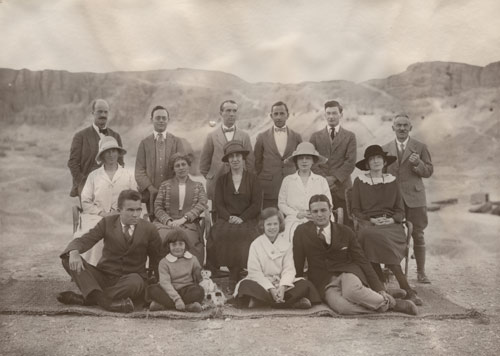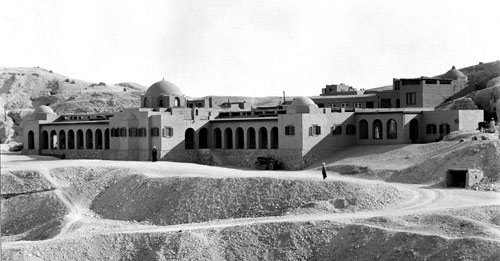 Traveling Exhibitions
Traveling Exhibitions Traveling Works of Art
Traveling Works of Art Conservation Projects
Conservation Projects Excavations
Excavations Fellows
Fellows Exchanges & Collaborations
Exchanges & Collaborations Multiple Items
Multiple Items
The Met Around the World presents the Met’s work via the global scope of its collection and as it extends across the nation and the world through a variety of domestic and international initiatives and programs, including exhibitions, excavations, fellowships, professional exchanges, conservation projects, and traveling works of art.
The Met Around the World is designed and maintained by the Office of the Director.
Traveling
Exhibitions
The Met organizes large and small exhibitions that travel beyond the Museum's walls, extending our scholarship to institutions across the world. See our national and international traveling exhibition program from 2009 to the present.
Traveling
Works of Art
The Met lends works of art to exhibitions and institutions worldwide to expose its collection to the broadest possible audience. See our current national and international loans program.
Conservation
Projects
The preservation of works of art is a fundamental part of the Met's mission. Our work in this area includes treating works of art from other collections. See our national and international conservation activities from 2009 to the present.
Excavations
The Met has conducted excavations for over 100 years in direct partnership with source countries at some of the most important archaeological sites in the world. Today we continue this tradition in order to gain greater understanding of our ancient collections. See our national and international excavation program from the Met's founding to the present.
Fellows
The Met hosts students, scholars, and museum professionals so that they can learn from our staff and pursue independent research in the context of the Met's exceptional resources and facilities. See the activities of our current national and international fellows.
Exchanges & Collaborations
The Met's work takes many forms, from participation in exchange programs at partnering institutions and worldwide symposia to advising on a range of museum issues. These activities contribute to our commitment to advancing the work of the larger, global community of art museums. See our national and international exchange program and other collaborations from 2009 to the present.
 The Metropolitan Museum Egyptian Expedition, 19 January, 1925: (back row, left to right) Herbert E. Winlock, Walter Hauser, Albert M. Lythgoe, Harry Burton, Charles K. Wilkinson, Norman de Garis Davies; (center row, left to right) Helen Winlock, Nina de Garis Davies, Lucy Lythgoe, Minnie Burton, Miss Willis; (front row, left to right) Walter Cline, Barbara Winlock, Frances Winlock, G. M. Peek. Archives of the Egyptian Expedition, Department of Egyptian Art.
The Metropolitan Museum Egyptian Expedition, 19 January, 1925: (back row, left to right) Herbert E. Winlock, Walter Hauser, Albert M. Lythgoe, Harry Burton, Charles K. Wilkinson, Norman de Garis Davies; (center row, left to right) Helen Winlock, Nina de Garis Davies, Lucy Lythgoe, Minnie Burton, Miss Willis; (front row, left to right) Walter Cline, Barbara Winlock, Frances Winlock, G. M. Peek. Archives of the Egyptian Expedition, Department of Egyptian Art.
Relief of King Amenemhat I
Middle Kingdom, Dynasty 12, reign of Amenemhat I–Senwosret I, ca. 1991–1952 B.C.
Egypt, Memphite Region, Lisht North, Pyramid Temple of Amenemhat I, MMA 1907
Rogers Fund, 1908 (08.200.5)

 Metropolitan House, home of the Egyptian Expedition at Qurna in western Thebes. Archives of the Egyptian Expedition, Department of Egyptian Art.
Metropolitan House, home of the Egyptian Expedition at Qurna in western Thebes. Archives of the Egyptian Expedition, Department of Egyptian Art.
Egypt
1906–1936
As director of the excavations, the Trustees appointed Albert M. Lythgoe, curator of the Egyptian Department, who had extensive archaeological experience in Egypt and had been the first curator of Egyptian art in Boston. In January 1907, Lythgoe began work in the cemeteries at Lisht, a site famous for its two Middle Kingdom pyramids belonging to Amenemhat I and his son Senwosret I of Dynasty 12 (ca. 1981–1917 B.C.). Lythgoe's co-director was Arthur C. Mace, and they were assisted by Metropolitan Museum Egyptologist Herbert E. Winlock, who later succeeded Lythgoe as head of the Egyptian Department and eventually became Director of the Museum.
In 1908, a concession was established at Kharga Oasis in an area with remains dating from Dynasty 27 (ca. 500 B.C.) to early Christian times. Almost thirty years later, in 1934, the Expedition began excavating at Hierakonpolis, one of the most important Predynastic sites in Egypt.
Excavations at Lisht
Lisht North
Lisht South
Excavations at Kharga Oasis
Temple of Hibis
The Cemetery of El-Bagawat and Ain et-Turba
Camel Caravan Trip from Kharga Oasis to Dakhla Oasis
Excavations at Hierakonpolis
Excavations at Thebes
In 1910, the Egyptian Antiquities Service granted the Museum a concession in western Thebes. Ancient Thebes (modern Luxor), on the east bank of the Nile, was the southern capital of Egypt and a great religious center, where the god Amun was worshipped. Across the river was the necropolis of western Thebes, one of the richest archaeological sites in the world. This vast area is best known for its cemeteries and royal mortuary temples that cover a period of more than two millennia. For twenty-six years, the Museum excavated monuments dating to the time of Mentuhotep II, founder of the Middle Kingdom (ca. 2010 B.C.); the female pharaoh Hatshepsut (ca. 1475 B.C.) and Amenhotep III (ca. 1350 B.C.) of Dynasty 18 in the New Kingdom; Dynasties 22–26 (ca. 945–525 B.C.); and the Early Christian or Byzantine period (A.D. 330–641/42).
For many years, the excavations at Thebes were directed by Herbert Winlock assisted by Ambrose Lansing and, later, William C. Hayes. A significant aim of the work was to make as complete a record as possible, in photographs as well as notes and drawings. A Graphic Section of the Expedition was established in 1907 under Norman de Garis Davies, and in 1914, photographer Harry Burton joined the staff. The services of both Burton and Arthur Mace (from Lisht) were donated to Howard Carter after his discovery of Tutankhamun's tomb in 1922.
Excavations at Thebes Assasif Malqata The Monastery of Epiphanius The Temple of Hatshepsut The Temple of Mentuhotep II Nebhepetre The Tombs of Meketre and Wah The Tombs of Dynasty 21: Menkheperre and Henettawy The Tomb of Merytamun and Nany The Tombs of Senenmut and His Family
The Graphic Section Facsimiles Harry Burton's Photographs Harry Burton and Tutankhamun

